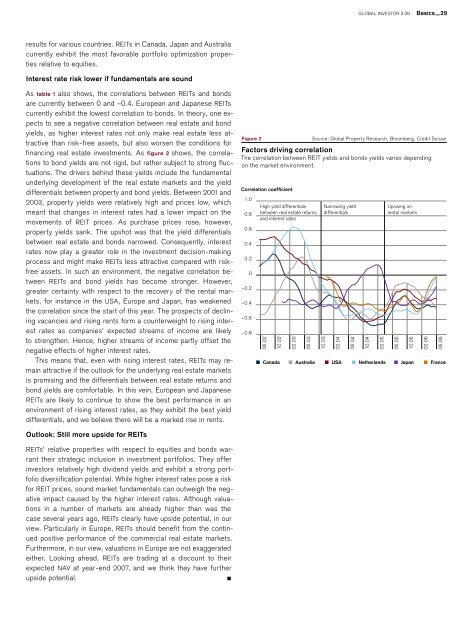Banking for 7 billion and 7 million
New challenges and opportunities of globalization Global Investor, 03/2006 Credit Suisse
New challenges and opportunities of globalization
Global Investor, 03/2006
Credit Suisse
Create successful ePaper yourself
Turn your PDF publications into a flip-book with our unique Google optimized e-Paper software.
GLOBAL INVESTOR 3.06 Basics — 29<br />
results <strong>for</strong> various countries. REITs in Canada, Japan <strong>and</strong> Australia<br />
currently exhibit the most favorable portfolio optimization properties<br />
relative to equities.<br />
Interest rate risk lower if fundamentals are sound<br />
As table 1 also shows, the correlations between REITs <strong>and</strong> bonds<br />
are currently between 0 <strong>and</strong> –0.4. European <strong>and</strong> Japanese REITs<br />
currently exhibit the lowest correlation to bonds. In theory, one expects<br />
to see a negative correlation between real estate <strong>and</strong> bond<br />
yields, as higher interest rates not only make real estate less attractive<br />
than risk-free assets, but also worsen the conditions <strong>for</strong><br />
financing real estate investments. As figure 2 shows, the correlations<br />
to bond yields are not rigid, but rather subject to strong fluctuations.<br />
The drivers behind these yields include the fundamental<br />
underlying development of the real estate markets <strong>and</strong> the yield<br />
differentials between property <strong>and</strong> bond yields. Between 2001 <strong>and</strong><br />
2003, property yields were relatively high <strong>and</strong> prices low, which<br />
meant that changes in interest rates had a lower impact on the<br />
movements of REIT prices. As purchase prices rose, however,<br />
property yields sank. The upshot was that the yield differentials<br />
between real estate <strong>and</strong> bonds narrowed. Consequently, interest<br />
rates now play a greater role in the investment decision-making<br />
process <strong>and</strong> might make REITs less attractive compared with riskfree<br />
assets. In such an environment, the negative correlation between<br />
REITs <strong>and</strong> bond yields has become stronger. However,<br />
greater certainty with respect to the recovery of the rental markets,<br />
<strong>for</strong> instance in the USA, Europe <strong>and</strong> Japan, has weakened<br />
the correlation since the start of this year. The prospects of declining<br />
vacancies <strong>and</strong> rising rents <strong>for</strong>m a counterweight to rising interest<br />
rates as companies’ expected streams of income are likely<br />
to strengthen. Hence, higher streams of income partly offset the<br />
negative effects of higher interest rates.<br />
This means that, even with rising interest rates, REITs may remain<br />
attractive if the outlook <strong>for</strong> the underlying real estate markets<br />
is promising <strong>and</strong> the differentials between real estate returns <strong>and</strong><br />
bond yields are com<strong>for</strong>table. In this vein, European <strong>and</strong> Japanese<br />
REITs are likely to continue to show the best per<strong>for</strong>mance in an<br />
environment of rising interest rates, as they exhibit the best yield<br />
differentials, <strong>and</strong> we believe there will be a marked rise in rents.<br />
Figure 2<br />
Correlation coefficient<br />
1.0<br />
High yield differentials<br />
0.8 between real estate returns<br />
<strong>and</strong> interest rates<br />
0.6<br />
0.4<br />
0.2<br />
0<br />
–0.2<br />
–0.4<br />
–0.6<br />
–0.8<br />
06.02<br />
10.02<br />
02.03<br />
06.03<br />
Source: Global Property Research, Bloomberg, Credit Suisse<br />
Factors driving correlation<br />
The correlation between REIT yields <strong>and</strong> bonds yields varies depending<br />
on the market environment.<br />
Narrowing yield<br />
differentials<br />
10.03<br />
02.04<br />
06.04<br />
Canada Australia USA Netherl<strong>and</strong>s Japan France<br />
10.04<br />
02.05<br />
Upswing on<br />
rental markets<br />
06.05<br />
10.05<br />
02.06<br />
06.06<br />
Outlook: Still more upside <strong>for</strong> REITs<br />
REITs’ relative properties with respect to equities <strong>and</strong> bonds warrant<br />
their strategic inclusion in investment portfolios. They offer<br />
investors relatively high dividend yields <strong>and</strong> exhibit a strong portfolio<br />
diversification potential. While higher interest rates pose a risk<br />
<strong>for</strong> REIT prices, sound market fundamentals can outweigh the negative<br />
impact caused by the higher interest rates. Although valuations<br />
in a number of markets are already higher than was the<br />
case several years ago, REITs clearly have upside potential, in our<br />
view. Particularly in Europe, REITs should benefit from the continued<br />
positive per<strong>for</strong>mance of the commercial real estate markets.<br />
Furthermore, in our view, valuations in Europe are not exaggerated<br />
either. Looking ahead, REITs are trading at a discount to their<br />
expected NAV at year-end 2007, <strong>and</strong> we think they have further<br />
upside potential.

















